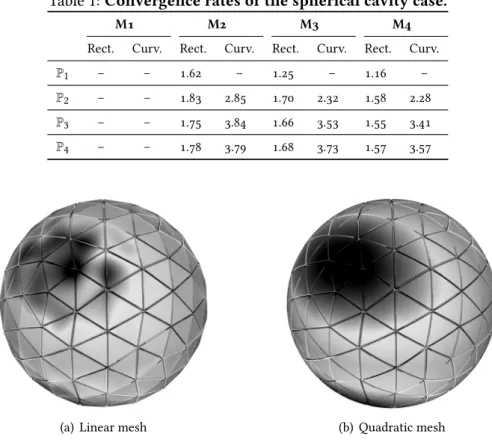HAL Id: hal-01403876
https://hal.archives-ouvertes.fr/hal-01403876
Submitted on 28 Nov 2016HAL is a multi-disciplinary open access archive for the deposit and dissemination of sci-entific research documents, whether they are pub-lished or not. The documents may come from teaching and research institutions in France or abroad, or from public or private research centers.
L’archive ouverte pluridisciplinaire HAL, est destinée au dépôt et à la diffusion de documents scientifiques de niveau recherche, publiés ou non, émanant des établissements d’enseignement et de recherche français ou étrangers, des laboratoires publics ou privés.
Curvilinear DGTD method for nanophotonics
applications
Jonathan Viquerat, Claire Scheid
To cite this version:
Jonathan Viquerat, Claire Scheid. Curvilinear DGTD method for nanophotonics applications. 6th In-ternational conference on advanced computational methods in engineering, Jun 2014, Gand, Belgium. �hal-01403876�
Book of abstracts of the 6thInternational Conference on Advanced Computational Methods
in Engineering, ACOMEN 2014 23–28 June 2014.
Curvilinear DGTD method for nanophotonics applications
Jonathan Viquerat1and Claire Scheid1,2
1Nachos project-team, INRIA Sophia Antipolis Méditerranée 2J.-A. Dieudonné laboratoy, University of Nice Sophia Antipolis
e-mails:jonathan.viquerat@inria.fr,claire.scheid@unice.fr
Abstract
Classical finite element methods rely on tessellations composed of straight-edged ele-ments mapped linearly from a reference element, on domains which physical boundaries are indifferently straight or curved. This approximation represents serious hindrance for high-order methods, since they limit the precision of the spatial discretization to second order. Thus, exploiting an enhanced representation of the physical geometry of a con-sidered problem is in agreement with the natural procedure of high-order methods, such as the discontinuous Galerkin method. In the latter framework, we propose and validate an implementation of a high-order mapping for tetrahedra, and then focus on specific nanophotonics setups to assess the gains of the method in terms of memory and per-formances.
Key words: Discontinuous Galerkin, curvilinear elements, Maxwell equations, nano-photonics
1
Curvilinear DGTD formulation
Classical discontinuous Galerkin time-domain (DGTD) methods rely on a linear mapping from a straight-edged reference element to each physical element of the mesh to evaluate the expressions of the finite-element matrices : this allows to save a lot in terms of compu-tational efficiency and memory consumption. Indeed, in the linear case, the finite element matrices for the physical elements are simply multiples of the precalculated matrices of the reference element, since the Jacobian of the corresponding transformation is a constant. In a curvilinear setting, the reference element is mapped to the physical element via a quadratic form, thus allowing a quadratic representation of boundaries. Therefore, the Jacobian of this transformation is no longer a constant, and the matrices have to be evaluated by means of numerical integration, and stored for each physical curved tetrahedron. Efficient quadrature and cubature rules can be easily found up to sufficient order to our purposes.
A DGTD scheme accouting for curved elements was formulated and implemented in the framework of Maxwell’s equations, using centered numerical fluxes. A validation step was conducted to verify the stability and accuracy of the method. Realistic situations related to the nanophotonics field will then be considered that demonstrate the potential of the approach, such as realistically-rounded metallic nanocubes described by a multipole dispersive model.
2
Validation
A spherical cavity of unit radius is considered, with PEC boundary conditions. A (0, 1, 1) mode is propagated inside it, which exact solution is known. Four different rectilinear meshes of increasing refinement were generated in order to check for h-convergence. P1to P4
polyno-mial approximations were used. For each simulation, the L2error is calculated over the whole mesh, and the maximum error levels is retained. The obtained h-convergence results are dis-played on table 1. As can be seen, the use of curvilinear tetrahedra restores quasi-optimal rates. Moreover, it allows to save a lot in terms of degrees of freedom, and therefore in CPU time. Indeed, the curvilinear M1 solution is three times faster and occupies three times less memory than the linear M2 solution, for a roughly similar error level. As an example, the P2
numerical solution on the M1 and M2 meshes are displayed on figure 2.
Table 1: Convergence rates of the spherical cavity case.
M1 M2 M3 M4
Rect. Curv. Rect. Curv. Rect. Curv. Rect. Curv. P1 – – 1.62 – 1.25 – 1.16 –
P2 – – 1.83 2.85 1.70 2.32 1.58 2.28
P3 – – 1.75 3.84 1.66 3.53 1.55 3.41
P4 – – 1.78 3.79 1.68 3.73 1.57 3.57
(a) Linear mesh (b) Quadratic mesh
Figure 1: P2numerical solution for the Ex field.
Acknowledgements
We would like to thank the French DGA (Defence procurement agency) for partial funding of J. Viquerat’s PhD thesis.
